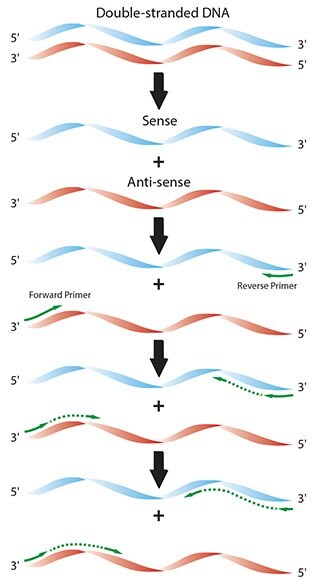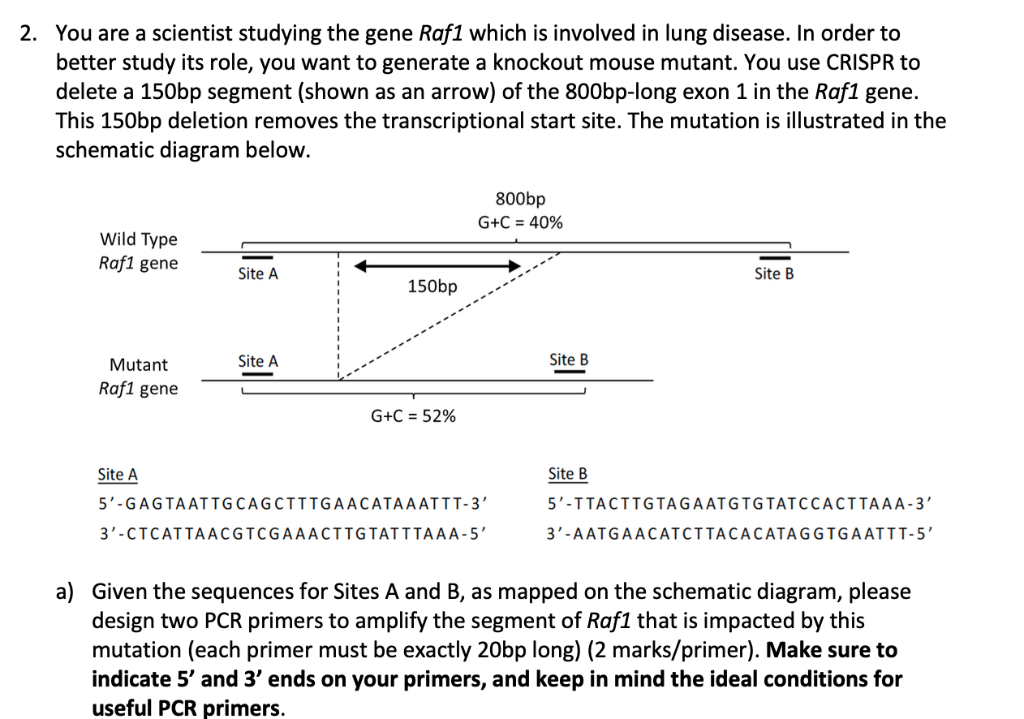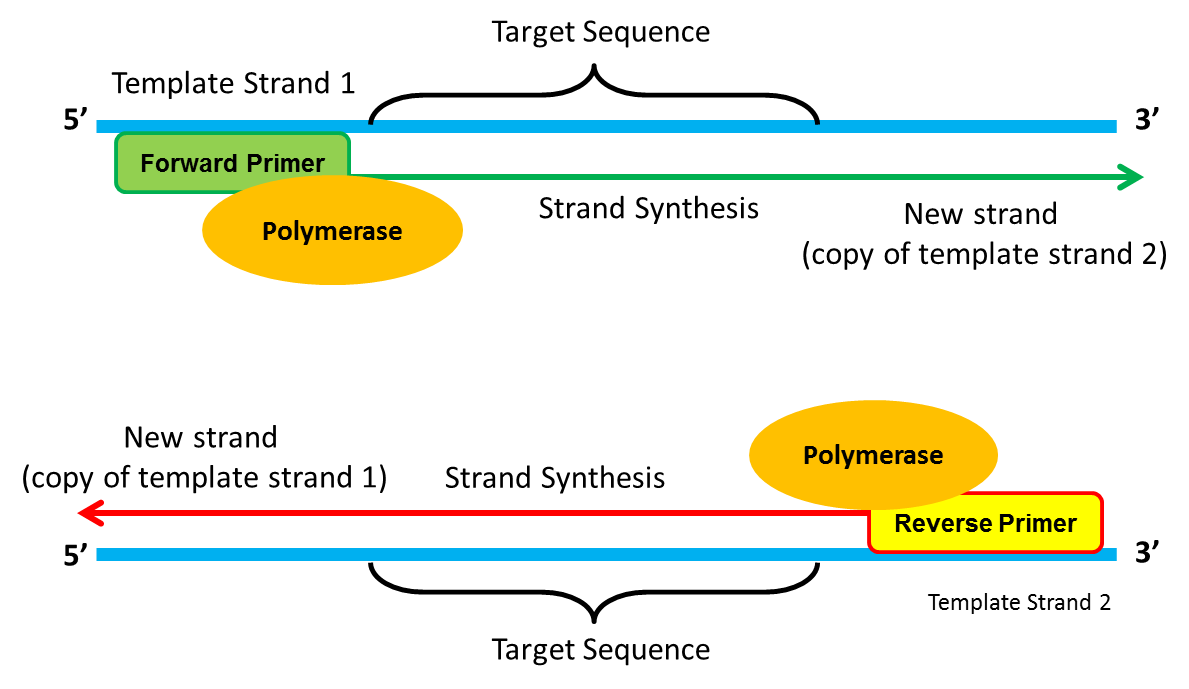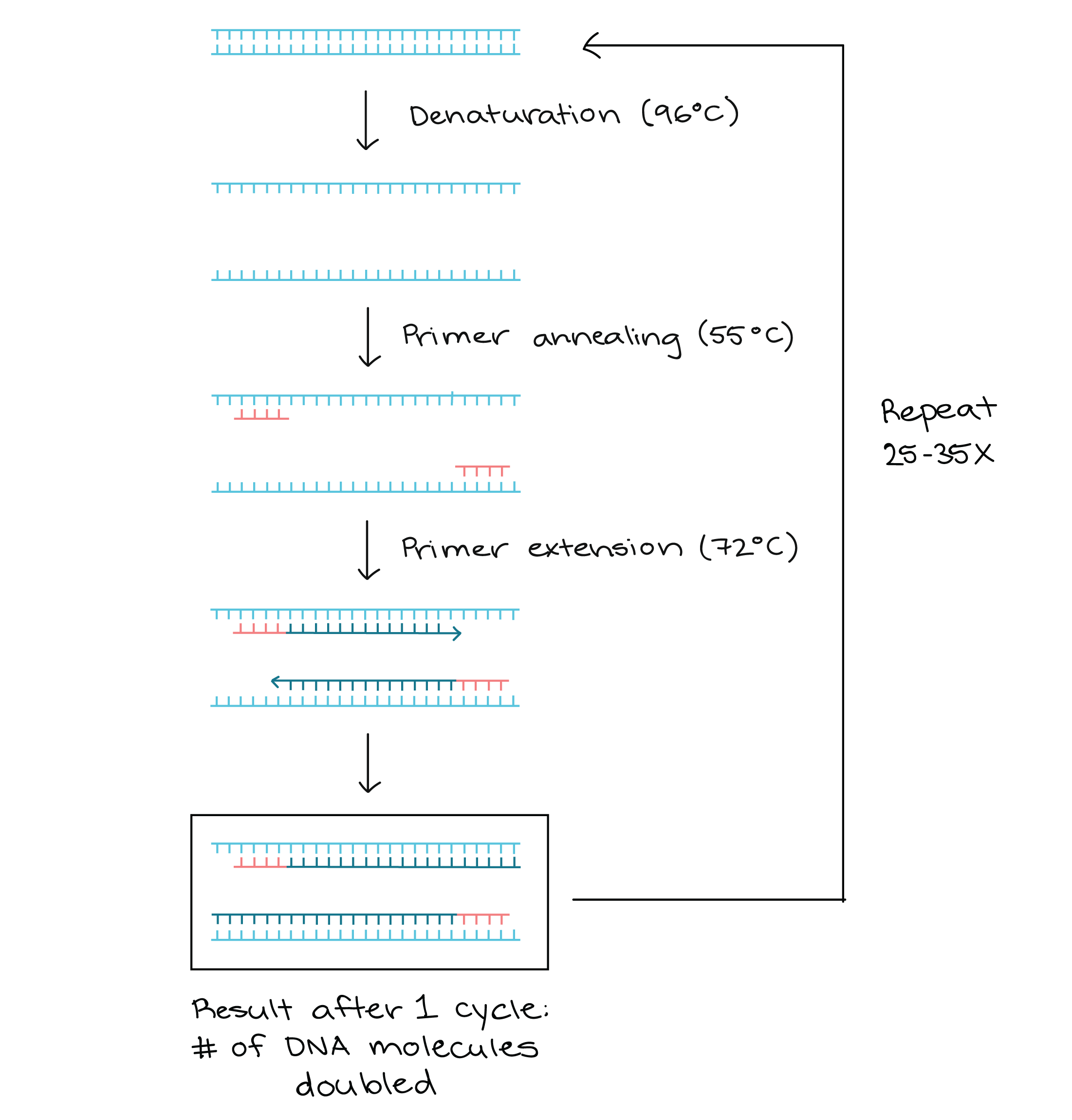Pcr Primers Diagram

Isothermal Amplification Strand Displacement Neb
.png?revision=1&size=bestfit&width=601&height=479)
6 5 Polymerase Chain Reaction Pcr Biology Libretexts

Pcr Overview Goldbio

Qpcr Assay Design And Optimization Lsr Bio Rad

Improved Pcr Specificity With Hot Start Pcr Primers Biotechniques

How Is The Amplification Of Gene Done Using The Technique Of Pcr Explain With The Help Of Diagram
A primer dimer (PD) is a potential by-product in the polymerase chain reaction (PCR), a common biotechnological method.

Pcr primers diagram. A schematic diagram illustrating the protocol for CRAS-PCR is presented in our previous study. The forward and reverse primer are used in a PCR while sequencing requires a single sequencing primer. This new technology, called Snake, was shown to supersede the conventional methods like TaqMan, Molecular Beacons, and Scorpions in the signal.
If the temperature is too low, the primer may bind imperfectly. Arguably one of the most powerful laboratory techniques ever discovered, PCR combines the unique attributes of being very sensitive and specific with a great degree of flexibility. Primers are an essential component in the amplification of DNA both in vivo and in vitro.
PCR primers for the qPCR step of RT-qPCR should ideally be designed to span an exon-exon junction, with one of the amplification primers potentially spanning the actual exon-intron boundary (Figure 4). We have applied thermodynamic and bioinformatic knowledge towards a suite of easy-to-use, online tools to help you design primers. The PCR process was originally developed to amplify short segments of a longer DNA molecule (Saiki et al.
This is indicative of an amplicon sequence that contains AT or GC rich regions or. PCR or Polymerase Chain Reaction is a technique used in molecular biology to create several copies of a certain DNA segment. LAMP is highly sensitive and specific DNA/RNA amplification technique.;.
They are known as forward primer and reverse primer. The PCR mechanism is as simple as its purpose:. The reason for doing so is to reduce the risk of unwanted products.
How Polymerase Chain Reaction Works Gene copies are made using a sample of DNA, and the technology is good enough to make multiple copies from one single copy of the gene found in the sample. Mullis, an American biochemist who won the Nobel Prize for Chemistry in 1993 for his invention. The polymerase enzyme can only add DNA bases to a double strand of DNA.
It is a fast and inexpensive way to amplify, or make many copies of, small segments of DNA.This is necessary because methods used for analyzing DNA (determining the DNA base pair sequence) require more DNA than may be in a typical sample. PCR stands for Polymerase Chain reaction. Second polymerase chain reaction step – DNA Primer annealing.
PCR has been one of the most important techniques developed in recent years. In vivo, the enzyme, DNA polymerase requires a primer for the initiation of DNA replication. This length is long enough for adequate specificity and short enough for primers to bind easily to.
Polymerase Chain Reaction (PCR) Introduction PCR (Polymerase Chain Reaction) is a revolutionary method developed by Kary Mullis in the 1980s. Furthermore, two PCR primers;. The amplification of gene is done by using the technique of PCR.
Denaturation by Heat 2. TOPO Cloning exploits this reaction to efficiently clone PCR products (see diagram below). Stable hydrogen bonds between complementary bases are formed only when the primer sequence very closely matches the template sequence.
For standard PCR, all you need is a DNA polymerase, magnesium, nucleotides, primers, the DNA template to be amplified and a thermocycler. Although the melt profile suggests products of varying Tm, the gel image indicates that a single amplicon is present. In that diagram, the nucleotides of the DNA are represented by a zippered line.
Include all the steps, labeled and in the right order. This tool is commonly used in the molecular biology and biotechnology labs. The main difference between PCR primers and sequencing primers is that the PCR primers are important for PCR amplification to obtain an amplicon, whereas the sequencing primers are important for sequencing a DNA fragment to reveal its nucleotide sequence.
The reporter is quenched by the secondary structure of the hairpin. A Basic Polymerase Chain Reaction Protocol. This design reduces the risk of false positives from amplification of any contaminating genomic DNA, since the intron-containing genomic DNA.
Let us make an in-depth study of the polymerase chain reaction, which is a technique for amplifying DNA sequences. Primer design is a critical step in a PCR protocol. The diagram on the right illustrates the entire PCR process.
Control samples known to contain desired DNA;. The design of the PCR primers to amplify your gene of interest is critical for expression. Therefore, the 1 st PCR forward/reverse primers need to be target gene specific that overlap with the N-terminal and C-terminal sequences of the ORF of the target gene.
Ensure that a valid combination of i7 and i5 primers is used. The polymerase chain reaction (PCR) is a test tube version of the same process of DNA replication that is found in the living cell. Such synthetic nucleotides can be readily produced with automated instruments based on the standard reaction scheme.
LUX PCR Primers These assays employ two DNA primers, one of which is a hairpin-shaped PCR primer with a fluorescent reporter attached near the 3' end, as illustrated in Figure 8. CHAPTER 1 i7 primers PCR plate i5 primers 1.1A.1. The polymerase chain reaction (PGR) amplifies a single piece of DNA across several orders of magnitude, see figure 6.2.
A) A melt profile and B) agarose gel analysis of a SYBR green I reaction. The first step for a single cycle is the denaturation step, in which the double-stranded DNA template molecule is made single-stranded. To sensitive and prone to contamination and small changes in condition Applications Complicated primer design vDisadvantages.
PCR is important because it can generate several copies of a DNA sequence in a very short time. Nested PCR – Once the initial PCR cycle is done, another PCR is done but this time with the use of a new primer nested within the original primer. Hence, primers are served as starting points of the synthesis of new strands.
Polymerase chain reaction (PCR) is a method widely used to rapidly make millions to billions of copies of a specific DNA sample, allowing scientists to take a very small sample of DNA and amplify it to a large enough amount to study in detail. The below given article will help you to understand the following things:- 1. Nested PCR reduces the nonspecific amplification of the target sequence.
LAMP is an innovative molecular diagnostic field and can be used for the diagnosis of infectious diseases, food inspection, environmental. Oligo (dT) primers, random primers, and sequence-specific primers are three types of primers commonly used here. Alternatively, 96-well deep well plates can be used and aligned against a PCR plate as in the diagram below.
As a result, the DNA polymerase amplifies the PD, leading to competition for PCR reagents, thus potentially inhibiting. Annealing Primer to Target Sequence 3. In fact, a repetitive sequence like GGGGG would be difficult to copy correctly.
(C) Sequence analysis of the PCR product showing AT richness. Real DNA sequences are more complex;. On the polymerase chain reaction page, I showed a simple diagram of how PCR works.
Poor design choices, erroneous or truncated sequences, and ineffective purification can lead to unusable results. (B) PCR product covering the gap. Google Classroom Facebook Twitter.
The Polymerase Chain Reaction (With Diagram) Article Shared by. Gene Cloning Before PCR. Contains a second set of primers and an unrelated target, which helps distinguish between a true neg and an amplification failure.
IST‑1 (EU), IST‑1.P (LO), IST‑1.P.1 (EK) A technique used to amplify, or make many copies of, a specific target region of DNA. A typical PCR procedure begins by heat-denaturation of a DNA sample into single strands. See Appendix A to verify that correct primer combinations have.
Annealing temperature for the PCR. The temperature for this step is typically in the range of 95-100°C, near boiling. It is a simple, cost-effective technique.;.
Genscript online pcr primer design tool for perfect PCR and sequencing primers design. Scorpions PCR primers contain a sequence complementary to an internal portion of the target sequence. Some of the major steps involved in polymerase chain reaction in DNA sequence are:.
We can avoid most of these problems using primers of 15- nucleotides in length (note that the examples in the diagrams below use 5 nucleotide primers for simplicity – we would not use these in a real PCR. Taq polymerase works only in 5’ to 3’ direction hence the DNA synthesis occurs in the same 5’ to 3’ direction. PCR products were sequenced directly or cloned into pCR 2.1 with the Invitrogen TA Cloning Kit (Invitrogen, San Diego, Cal-if.) and then sequenced.
The Polymerase Chain Reaction (PCR) is a technique for the amplification of DNA in vitro (this describes experiments with cells outside their normal environment). The function of reverse transcriptase plays an important role to make the present technique successful. A typical amplification reaction includes target DNA, a thermostable DNA polymerase, two oligonucleotide primers, deoxynucleotide triphosphates (dNTPs), reaction buffer and magnesium.
The primers are designed to be complementary in sequence to short sections of DNA on each end of the sequence to be copied. In vitro, primers are mostly used for the initiation of polymerase chain reaction (PCR).Some other techniques including sequencing, cloning, site-directed mutagenesis, etc. Inserts were reamplified from clones us-ing the primers of the original cloned PCR product by picking the bacterial colonies with a toothpick directly into the PCR reaction.
What is the importance of PCR?. Combining the index primers during the PCR amplification step. PCR is based on using the ability of DNA polymerase to synthesize new strand of DNA complementary to the offered template strand.
Used to see if PCR can produce the desired product Internal amplification control (not included in all PCR):. The accuracy of design and synthesis of a primer pair is the most important consideration to generate good PCR performance data. Lastly, the forward and reverse primers should not be complementary, or they will anneal to each other and form a “primer dimer”.
The polymerase chain reaction (PCR) is the cardinal laboratory technology of molecular biology. As its name implies, a PD consists of two primer molecules that have attached to each other because of strings of complementary bases in the primers. The amplification of a specific cDNA by the polymerase chain reaction (PCR).
Polymerase chain reaction steps. To detect HIV, PCR primers are made for sequences in the virus, and a. Depending on the pET TOPO vector you are using, consider the following when designing your PCR primers.
The synthesis of cDNA (complementary DNA) from RNA by reverse transcription (RT) and ;. If it is too high, the primer may not bind at all. In general, a single PCR run will undergo 25-35 cycles.
Primers serve as the starting point for DNA synthesis. Because DNA polymerase can add a nucleotide only onto a preexisting 3'-OH group, it needs a primer to which it can add the. This is a typical temperature-dependent DNA :.
At the annealing step, DNA primers line up on exposed nucleotide sequences at the DNA target according to base-pairing rules. (If you are completing this handout online, draw the diagram on a piece of paper, take a photo, save the image as a PDF, and upload it in the space below.) 2.What does the Master Mix contain?. Please refer to the diagram below.
Following the WASP principles, two pairs of forward (or reverse) primers and a common reverse (or forward) primer were designed for TPMT*3B and TPMT*3C genotyping. Notice that the primers are complementary to the flanking sides of the DNA sequence of interest. The reason behind is its simplicity of the reaction and relative case of the practical manipulation steps.
However, which primer is applied, it depends on the type of RT-PCR assay. The 1 st PCR aims to connect the target ORF sequence with the 2 nd forward/reverse primers (please see the diagram below). The addition of relatively short flap sequence at the 5′-end of one of the polymerase chain reaction (PCR) primers considerably improves performance of real-time assays based on 5′-nuclease activity.
DNA hybridization reaction and has to be optimized. 1) double-stranded DNA (dsDNA) is heat denatured, 2) primers align to the single DNA strands and 3) the primers are extended by DNA polymerase, resulting in two. The technique consists of two parts:.
This allows for the Taq polymerase to synthesize the complementary strand, resulting in exponential duplication of the original DNA segment. Designing PCR Primers for Directional TOPO Cloning. Making identical copies, in this context, is known as cloning.In the diagram below, the gene of interest (f) is inserted into a plasmid, creating recombinant DNA.
Read this article to learn about the stages, primer design, types, sensitivity, factors affecting, applications and variations of polymerase chain reaction. The set of primers should flank the fragment you intend to amplify from the DNA template. Why is a primer added?.
Polymerase chain reaction (PCR) AP.BIO:. In contrast, a machine designed to carry out PCR reactions can complete many rounds of replication, producing. Assembly PCR – Overlapping primers are used to amplify longer fragments of DNA.
Real PCR primers are longer, often from to 40 nucleotides long. Introduction to genetic engineering. In a previous tutorial, we explored how plasmids (letter “c” below) can be used to copy a gene.
The forward primer will anneal with 3’-5’ DNA strand and the reverse primer will anneal with the 5´-3’ DNA strand. The second requirement for PCR is the ability to synthesize oligonucleotides at least 18– nucleotides long with a defined sequence. PCR was developed in 19 by Kary B.
End of the First PGR Cycle. Nested Polymerase Chain Reaction (PCR) Nested PCRs are sometimes necessary to compensate for inefficient first-round PCR due to primer mismatches so, if we can use well-matched primers for first-round PCR nested approach may not be needed in many circumstances. (A) Diagram of the structure of the clone with gap and PCR primers designed shown.
It is generally accepted that the optimal length of PCR primers is 18-22 bp. Before the development of PCR, the methods used to amplify, or generate copies of, recombinant DNA fragments were time-consuming and labour-intensive. PCR was invented in 1984 by the American biochemist Kary Mullis at Cetus Corporation.It is fundamental to much of genetic testing including analysis of.
The PCR is …. Since DNA is double stranded, two types of primers are needed in PCR. PCR enables the production or amplification of billions of copies of an original piece of DNA in the tube with minutes or hours.
Primers are single strands of DNA or RNA sequence that are around to 30 bases in length. RT-PCR (Reverse transcriptase-polymerase chain reaction) is a highly sensitive technique for the detection and quantitation of mRNA (messenger RNA). A single PCR reaction involves three temperature-dependent steps, described as follow:.
There are two sets of forward and reverse primer sets. The polymerase chain reaction is a molecular genetic technique for making multiple copies of a gene and is also part of the gene sequencing process.

Primersuite A High Throughput Web Based Primer Design Program For Multiplex Bisulfite Pcr Scientific Reports

Polymerase Chain Reaction Pcr Article Khan Academy

Polymerase Chain Reaction Pcr Process Guide Sigma Aldrich

Why We Need Antigen And Antibody Tests For Covid 19 The Native Antigen Company

Specific And Effective Detection Of Anammox Bacteria Using Pcr Primers Targeting The 16s Rrna Gene And Functional Genes Sci Total Environ X Mol

Sequencing Forensic Analysis And Genetic Analysis

Pcr

Introduction To Pcr Primer Probe Chemistries Lsr Bio Rad

Polymerase Chain Reaction Wikipedia

Schematic Outline Of Inverse Fusion Pcr Cloning Ifpc Primer Design

Pcr And Directed Mutagenesis

Dna Primer An Overview Sciencedirect Topics

How To Calculate Pcr Primer Efficiencies

Setting Up The Pcr Reaction Nebnext Multiplex Oligos For Illumina Dual Index Primers Set 2 E7780 Neb

Linear After The Exponential Late Pcr An Advanced Method Of Asymmetric Pcr And Its Uses In Quantitative Real Time Analysis Pnas

Figure 1 From Use Of Pcr Primers Containing A 3 Terminal Ribose Residue To Prevent Cross Contamination Of Amplified Sequences Semantic Scholar

ged Highly Degenerate Primer Thdp Pcr For Community

Schematic Summary Of Arms Pcr Primer Design And Dna Gel Patterns Of The Download Scientific Diagram

What Is Pcr Science Learning Hub

Pcr Reaction Ten Secrets That Nobody Tells You Plant Science Primer Design Dna Polymerase

Pcr Protocol Pcr Steps How To Do Pcr

Pcr Primers Eurofins Bioz Ratings For Life Science Research

Fd 5357 Diagram Showing Steps Of Pcr Download Diagram

With The Sequences For Sites A And B As Mapped On Chegg Com

The Most Common Questions About Our Indexing Pcr And Sequencing Primer Kit

Pcr Primer Desining

Addgene Protocol How To Design Primers

What Is Pcr Polymerase Chain Reaction Facts Yourgenome Org

Expanded Genetic Alphabets In The Polymerase Chain Reaction Yang 10 Angewandte Chemie Wiley Online Library

Real Time Pcr Qpcr Technology Basics Biosistemika

Pcr In Detail

Schematic Diagram Of Nested Pcr The First Pair Of Primers Amplifies Download Scientific Diagram

Sequencing Forensic Analysis And Genetic Analysis

Schematic Drawing Of The Prase Procedures A Nested Mul Open I

Polymerase Chain Reaction Pcr Article Khan Academy

Standardization And Quality Control Studies Of Real Time Quantitative Reverse Transcriptase Polymerase Chain Reaction Of Fusion Gene Transcripts For Residual Disease Detection In Leukemia A Europe Against Cancer Program Leukemia

Site Directed Mutagenesis By Polymerase Chain Reaction Intechopen

Pcr Introduction Abm Inc

Glen Report 21 11 Hot Start Pcr Update Cleanamp Primers

If We Add Only 1 Primer In Pcr Biology Stack Exchange

Allele Specific Bna Primer Design
Q Tbn 3aand9gcszzhknn2u9bn S5rby7j 6g4ugqs1tyactlxpbr Bg9idfwqhb Usqp Cau

Gene Quantification Real Time Pcr Dyes And Chemistries

Custom Dna Sequencing Sequencing Optional Services Hokkaido System Science Co Ltd
Biorender Life Science Icons

Gene Quantification Real Time Pcr Dyes And Chemistries

Schematic Depiction Of Gap Primer Pcr Gppcr Based Formation Of Dna Download Scientific Diagram

Real Time Polymerase Chain Reaction Wikipedia

Polymerase Chain Reaction Pcr Diamantina Institute University Of Queensland

Mlab 2378 Fundamentals Of Molecular Diagnostics Links

A Cornerstone Of Molecular Biology The Pcr Reaction Antisense Science

Diagram Of Polymerase Chain Reaction Pcr Primer Design A Download Scientific Diagram

Colony Pcr Exercises Pathways Over Time

Primer Design For Pcr Reactions In Forensic Biology Springerlink

Diagram Of The Dual Primer Labeling And Multiplexing Method In The Fi Download Scientific Diagram

Principle Of The Pcr

Addgene Plasmid Cloning By Pcr With Protocols
Real Time Pcr Quantification Of Spliced X Box Binding Protein 1 Xbp1 Using A Universal Primer Method

Rnase H Dependent Pcr Rhpcr Improved Specificity And Single Nucleotide Polymorphism Detection Using Blocked Cleavable Primers Bmc Biotechnology Full Text

A Refined Two Step Oligoribonucleotide Interference Pcr Method For Precise Discrimination Of Nucleotide Differences Scientific Reports

Multiplex Pcr An Overview Of Multiplex Pcr Assay Primer Design For Multiplexing Primer Design Software For Multiplex Pcr

Crosslinking Of Pcr Primers Reduces Unspecific Amplification Products In Multiplex Pcr Sciencedirect

Basic Principles Of Rt Qpcr Thermo Fisher Scientific Us
Plos One Novel Pcr Primers For The Archaeal Phylum Thaumarchaeota Designed Based On The Comparative Analysis Of 16s Rrna Gene Sequences

Polymerase Chain Reaction Pcr Molecular Biology The Biology Notes
Q Tbn 3aand9gcs4odcmvxrqmgg1rkwiwzzmacyljwtbifdjap Tatc1xg7l Nli Usqp Cau

Introduction To Pcr Primer Probe Chemistries Lsr Bio Rad
Diagram Indicating Pcr Primer Positions And Amplicon Sizes Primers Hs1 Download Scientific Diagram
Q Tbn 3aand9gcqykfx 4rc901zg0gssn58qeemi Jy44szssmj X91mtptrbgdk Usqp Cau

Rt Qpcr Quantitative Reverse Transcription Pcr Sigma Aldrich

Real Time Polymerase Chain Reaction Microrna Gene Primer Diagram Genotyping Transparent Png

Solved 2 You Are A Scientist Studying The Gene Raf1 Whic Chegg Com
Q Tbn 3aand9gcqzninymvxcoxl6ityd4zga 5jbhu67honfuwvj3pcas6qidmae Usqp Cau

Solved Incorrect Question 1 0 2 Pts A Microbiologist Has Chegg Com

Polymerase Chain Reaction Pcr Diamantina Institute University Of Queensland

Overhang Pcr

Pcr For Sanger Sequencing Thermo Fisher Scientific Us
Http Www Aun Edu Eg Molecular Biology Workshop realtime 17 2 realtime pcr final Pdf

Real Time Pcr Principle Procedure Advantage Limitations And Applications

Site Directed Mutagenesis By Polymerase Chain Reaction Intechopen

Reverse Transcriptase Cdna Overview Applications Goldbio

Pcr Primer Design Guidelines

Pcr The Basics Of The Polymerase Chain Reaction Medical Laboratory Observer

Imatinib Independent Aberrant Methylation Of Nov Ccn3 In Chronic Myelogenous Leukemia Patients A Mechanism Upstream Of r Abl1 Function Cell Communication And Signaling Full Text

Diagram Of Pcr

The Different Phases Of Pcr And Why They Are Important

Using Primer Design Tools For Pcr Qpcr Idt

Pcr Primers A Primer Virology Down Under

Pcr And Molecular Biology Fundamental Principles
%20PCR%20works_big.png)
Rt Pcr Reverse Transcription Pcr Sigma Aldrich

Multiplex Pcr Primer Design Software Panelplex Information Dissemination Media For Research And Development Tegakari

Barcode Of Life Simple Laboratory Workflows For 16s And Co1 Genus And Species Identification

Polymerase Chain Reaction Pcr Article Khan Academy

Site Directed Mutagenesis By Polymerase Chain Reaction Intechopen

Pcr

Enhanced Mutant Screening In One Step Pcr Based Multiple Site Directed Plasmid Mutagenesis By Introduction Of Silent Restriction Sites For Structural And Functional Study Of Proteins Springerlink

Polymerase Chain Reaction Pcr Article Khan Academy

Polymerase Chain Reaction Pcr Article Khan Academy



